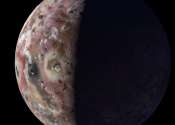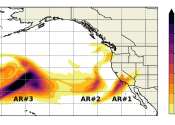El Nino not climate change driving southern Africa drought: Study
A drought that pushed millions of people into hunger across southern Africa has been driven mostly by the El Niño weather pattern—not climate change, scientists said on Thursday.

A drought that pushed millions of people into hunger across southern Africa has been driven mostly by the El Niño weather pattern—not climate change, scientists said on Thursday.
Earth Sciences
19 hours ago
0
10

Land subsidence is overlooked as a hazard in cities, according to scientists from the University of East Anglia (UEA) and Virginia Tech. Writing in the journal Science, Prof Robert Nicholls of the Tyndall Center for Climate ...
Earth Sciences
10 hours ago
0
27

California's second wet winter in a row has left L.A's water supplies in good shape for at least another year, but the inevitable return to dry conditions could once again put the city's residents in a precarious position.
Environment
15 hours ago
0
48

Scientists on NASA's Juno mission to Jupiter have transformed data collected during two recent flybys of Io into animations that highlight two of the Jovian moon's most dramatic features: a mountain and an almost glass-smooth ...
Planetary Sciences
8 hours ago
0
109

Drylands in the western United States are currently in the grips of a 23-year "megadrought," and one West Virginia University researcher is working to gain a better understanding of this extreme climate event.
Earth Sciences
10 hours ago
0
44

A new theory suggests that Titan's majestic dune fields may have come from outer space. Researchers had always assumed that the sand making up Titan's dunes was locally made, through erosion or condensed from atmospheric ...
Planetary Sciences
9 hours ago
0
18

Researchers have discovered new white shark behaviors by attaching smart tags and cameras to their fins, revealing never-before-seen details of the lives of the elusive creatures.
Plants & Animals
9 hours ago
0
12

A new study from Charles Darwin University (CDU), Monash University and The University of Newcastle has presented almost 100,000 estimates of groundwater recharge rates across Australia, by far the largest known database ...
Earth Sciences
7 hours ago
0
11

In California's 2022-2023 winter season, the state faced nine atmospheric rivers (ARs) that led to extreme flooding, landslides, and power outages—the longest duration of continuous AR conditions in the past 70 years. Scientists ...
Earth Sciences
7 hours ago
0
57
Water is a ubiquitous chemical substance, composed of hydrogen and oxygen, that is essential for the survival of many known forms of life. In typical usage, water refers only to its liquid form or state, but the substance also has a solid state, ice, and a gaseous state, water vapor or steam. Water covers 71% of the Earth's surface. On Earth, it is found mostly in oceans and other large water bodies, with 1.6% of water below ground in aquifers and 0.001% in the air as vapor, clouds (formed of solid and liquid water particles suspended in air), and precipitation. Saltwater oceans hold 97% of surface water, glaciers and polar ice caps 2.4%, and other land surface water such as rivers, lakes and ponds 0.6%. A very small amount of the Earth's water is contained within biological bodies and manufactured products. Other water is trapped in ice caps, glaciers, aquifers, or in lakes, sometimes providing fresh water for life on land.
Water moves continually through a cycle of evaporation or transpiration (evapotranspiration), precipitation, and runoff, usually reaching the sea. Winds carry water vapor over land at the same rate as runoff into the sea. Over land, evaporation and transpiration contribute to the precipitation over land.
Clean, fresh drinking water is essential to human and other lifeforms. Access to safe drinking water has improved steadily and substantially over the last decades in almost every part of the world. There is a clear correlation between access to safe water and GDP per capita. However, some observers have estimated that by 2025 more than half of the world population will be facing water-based vulnerability. Water plays an important role in the world economy, as it functions as a solvent for a wide variety of chemical substances and facilitates industrial cooling and transportation. Approximately 70 percent of freshwater is consumed by agriculture.
This text uses material from Wikipedia, licensed under CC BY-SA